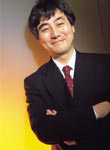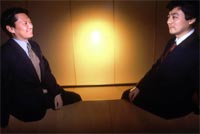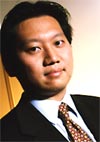Toru Arakawa: Small-Time Visionary
Back to Contents of Issue: May 2001
|
|
|||||
|
by Kyoko Fujimoto |
|||||
 It's official: we're living in small times. Portability and miniaturization are the word when it comes to the devices we use to live, work, and play. The days when Sony CEO Akio Morita had difficulty selling the idea that portable, personal music devices would be popular are long gone. More and more functionality is being crammed into ever smaller machines, and it's accepted wisdom that this is what people want (see also "Convergence Emergence," page 36). It's official: we're living in small times. Portability and miniaturization are the word when it comes to the devices we use to live, work, and play. The days when Sony CEO Akio Morita had difficulty selling the idea that portable, personal music devices would be popular are long gone. More and more functionality is being crammed into ever smaller machines, and it's accepted wisdom that this is what people want (see also "Convergence Emergence," page 36).
In 1979, Access began as a two-man startup developing software for industrial devices. The founders, Toru Arakawa (president and CEO) and Tomihisa Kamada (vice president and CTO) were unusually entrepreneurial and, as time has proven, visionary. An excerpt from their Web site (www.access.co.jp) follows: "By the mid-1980s, we were confident that the time would soon come when the Internet would be accessible to everyone. We also predicted that the tools used to access the Internet would not be PCs, but dedicated Internet terminal devices, including small, easy-to-operate home appliances that would be both compact and simple to use. We focused on the development of standard software for these dedicated Internet terminal devices ..." Talk about long-term planning. Remember, this was the early '80s -- not '90s. The Internet was not on that many radar screens back then. Today, the company's main products, the NetFront and Compact NetFront browsers, are found in Internet cellphones, wireless Web surfing boards, email pocket devices, game consoles, car navigation systems, et cetera. If it's an appliance that can connect to the Internet -- particularly a small one -- there's a strong possibility a product from Access is embedded in it. For manufacturers, Access provides nearly everything needed to turn a stand-alone device into a Net terminal. This includes the browsers, a real-time OS based on iTRON, a Java virtual machine, and, for making other embedded applications, a TCP/IP protocol stack, a file system, a Web server, and an encryption module. Compact NetFront Plus, the latest version of the browser, is notable in that it can read almost any site format: cHTML, WML, xHTML Basic. Access is in the red. About 90 percent of its earnings comes from the development work behind bundling the browsers into devices and from royalties it receives from each device sold. But now that its systems are in so many devices, the company has "access" to all sorts of leveraging opportunities. And as this interview shows, the company has some very innovative, compelling plans that should lead to profitability in the next few years. Access IPOd on the Tokyo Stock Exchange's Mothers market in late February. For investor H&Q Asia Pacific, it was a particularly exciting moment: Access was its first portfolio company in Japan to go public. Associate Editor Kyoko Fujimoto interviewed Access CEO Toru Arakawa and H&Q Asia Pacific Vice President Pierre Suhandinata (also a board member of Access) at the Four Seasons Hotel in Tokyo.
Also, regarding account settlements, there was an announcement that we'll make a system together with a number of credit card companies. The idea is to put an account settlement setup in devices like cellphones and televisions. Their sponsoring of the settlement step was for Access an extremely important thing. Establishing an ASP company for non-PCs with Justsystem and Mets was also very important. We're just now developing that platform, and we expect it to become very important. Anything else? Another important event that we played a part in was creating the joint venture Mobile Business Communi-cations. The company is a new venture that has Access as a partner, CTC as a partner, and BroadVision as a partner, and it's funded by H&Q Asia Pacific. The goal of the business is basically to create mobile applications for corporate customers. Up till now, everything has been consumer-based [i-mode, et cetera]. In the future, there will be big applications for businesses. And I think what that does for Access is, first, it's an additional partner that is very strong. BroadVision is known worldwide as the No. 1 e-commerce solution. And they believe that Access is the best partner to launch mobile business applications. In what way will you move toward the business side? The second is to move overseas, via tie-ups or by establishing subsidiaries. The third is to apply that: to prioritize various services and contents, to get wide-ranging opportunities for earnings. At the same time, if we're supported by services and by content, it strengthens our browser's position even more. So by handling these combinations well, the opportunities for earnings increase, and the value of our browser goes up. You're not going to provide content yourself, are you? The other is for us to plan and provide our own content. This is something we're preparing for to a degree, but at this point ... it's not good for us to antagonize content and service providers. What we're working on is finding a way to use well the other things that we do have and figuring out what we can do to create earnings opportunities in those areas. You have something like a portal site, Gaburi. Is that part of the overall strategy?
Arakawa: Well, we do think that earnings will eventually rise as a result of it, but in order to do that, we need an online payment system. With devices other than the PC, we can't really use the system that we usually use. That's why we're making the system with the credit card companies. If that is used in the devices, content providers will have an opportunity to charge users, and we'll get commissions from that. Another one is the ad broadcast system for which we're tying up with DoubleClick. By doing that, we also gain revenues through advertisements, so that's another earnings opportunity. In order for Gaburi to be active, we have to set up the system so that the content providers also have increased opportunities for earnings. That's what our company is working on now. How about the overall earnings of Access? You have several businesses, but is the browser your major source of earnings? About how much of your earnings does that make up? But you're also doing all these other things ... You just went public. Can you tell me about your future business developments? Does this mean you expect keitai Internet access overseas to expand? There have been some complaints by foreigners that keitais are too small. Foreigners generally prefer large products. Also, the market for home-use gaming devices. Although these days it's sort of down, we expect there to be quite a large number of users, so this is also an area we can't miss. Another one is cars: car navigation with Internet functions as a standard feature. There are some already being sold, but those are still in a transition stage, and the real boom won't come until after the 3G cellphones come out. Otherwise, data transmission takes too much time, and you wouldn't really be in a position to search for information while driving. Also, the act of connecting the cellphone is very cumbersome, so if we have Bluetooth, used for short-distance exchanges, that can become the gateway to the communication access point. The present kind of Internet-compatible car navigation provides map and location information, but this alone can't help you when you want to find out about restaurants or something of a specific genre that's nearby. So what we're trying to introduce is a way for [a driver] to connect to the Internet via wireless and get search results -- this is where you are now, here is this kind of restaurant, and here's how you can get to it. So once the communication system advances, Access will make substantial efforts in the car-navi area, too? Also, although I mentioned three areas before, there is one more that is very large: home-use telephones [using services like i-mode]. I think that will be a very big market in Japan. I think this product will be very big this year or next year, and that is one thing we are also looking forward to. When it comes to embedded-system devices, Access is in quite a strong position, right? Whenever I see that kind of product, I automatically think it must be from Access.
Suhandinata: Well, it started in 1996, with H&Q Asia Pacific chairman Ta-lin Hsu. [A friend of his] was advising Access then. So the relationship started in 1996 through an introduction. We tried to support Access and keep a good relationship. At the end of 1998, Access was raising a venture capital round. We liked Arakawa-san, and we really liked the vision. Ta-lin Hsu always says that the first thing he liked about Arakawa-san was his vision that Access is going to be the Microsoft of non-PC devices. And that's really what brought us together. So that relationship, in terms of financial support, started in late 1998. So you've known Arakawa-san since 1998. And you became a board member at Access after that? And do you believe that Access is going to be the Microsoft of non-PC devices? If you look at the example of the Internet, there are a lot of people trying to control it, and the way to be successful is to have it be an open standard. And I think in that light, Access is very strong, because they work with so many manufacturers. They work with carriers, they work with content providers. Also very key is that there are standards bodies in the world, all debating about which standard to go to, and Access is a key member of the W3C forum, which basically decides which standard is going to be next for phones. So if you take all those together, I think you will find very, very few Japanese companies as strong as Access. What kind of business are you developing in America? What is the relationship between your businesses in Japan and America? It's not decided, then, which area the US will focus on? What about outside of America? Are you yourself also chairman of the US side? Kamada-san is CTO, right? So on the technology front Mr. Kamada is doing everything at this point, right? When you started out, it was just the two of you, right? So you had to do everything. How long was it just the two of you? It's that big? You've nearly doubled in size in a year. Do engineers make up the bulk of that growth? Companies that have technology are strong. Compact NetFront is your top product, right? When do you expect to come out of the red? When we license software to manufacturers, they ask us to bundle it into their products. We get paid for that, but at the same time we need developers to do the bundling. We need a new development team for each new order. This is getting burdensome. The development period actually takes anywhere from 8 to 12 months to fit it into a particular device. This takes up all of these people's time, and we get paid for that after all the development is done. That's a tough system for us. Last year we did this for about 40 products, and in the past five years we had a total of 90 products. This year we will have about 100 products, from what we know now. In a way, our being in the red is not unhealthy. But we can't stay red forever, and we can't get more engineers as our orders increase. The reason why we've been getting orders like this is because there are no software developers at the manufacturers. So we've developed an SDK, or software development kit. It's like an assembler to make development easy. We've been selling this for the past couple of years. Actually, it's impossible to develop 100 kinds of product a year! We had to outsource this part somehow, and now we are ready. Many have already used the kit, like for the digital-camera keitai from J-Phone, and Sony's air board. Until now, we've had to spend too much money on development. But now we have this kit, so our profitability will be greater. Actually, if we do accept more development orders, our sales will increase. But if we become too big, it becomes harder to manage all the people, and it becomes harder to catch up with the speed in this industry. We would like to stay at this size -- 300 people at most -- and we plan to outsource things efficiently to subsidiaries and partners. Which next step is the most important? Java-enabled keitai have been released. What's your take on them? What is Access' strongest point? What's the important thing for keeping Access as strong as it is now? We have usually tried to look ahead, predict the future, and propose to make changes so as to become the market leader. If we can keep doing this, we'll be OK. Since we just went public, more people are watching us. I think it's a good time to straighten ourselves up. |
|||||
Note: The function "email this page" is currently not supported for this page.








